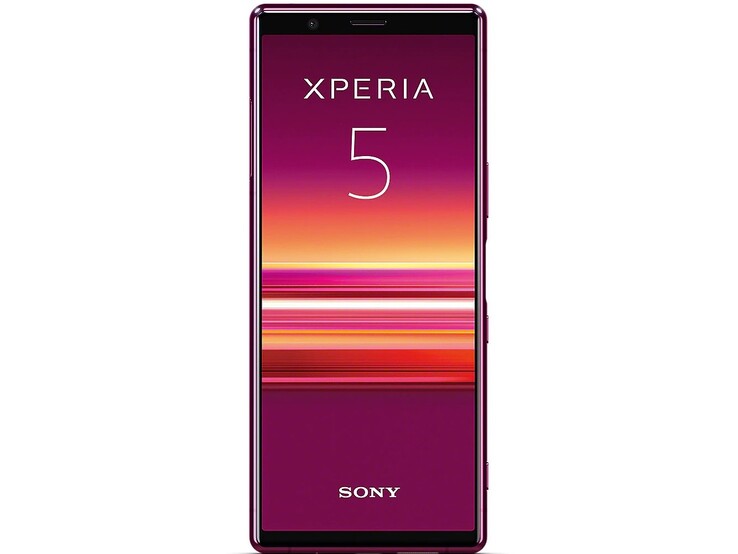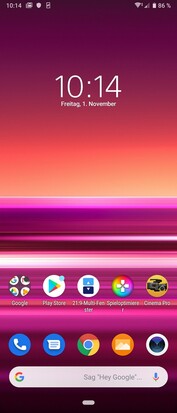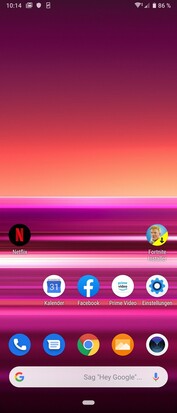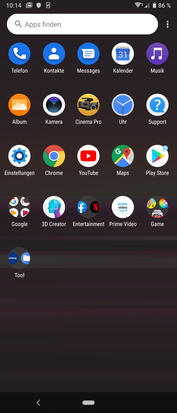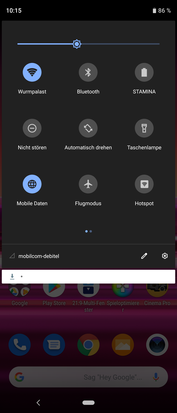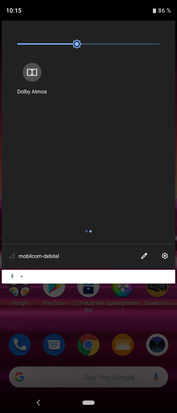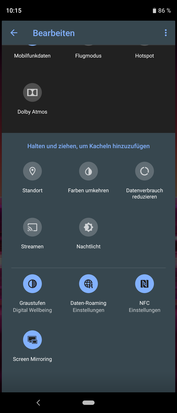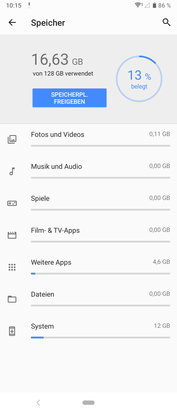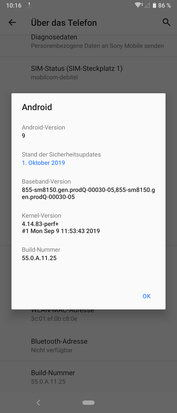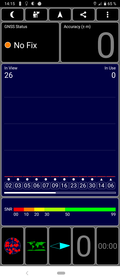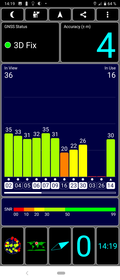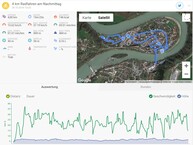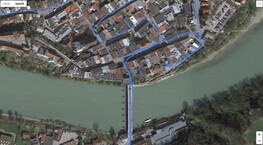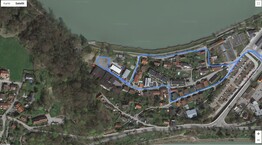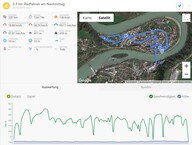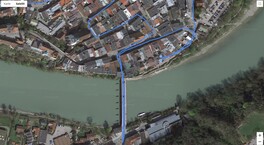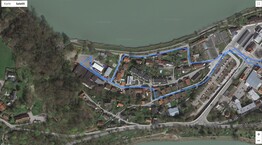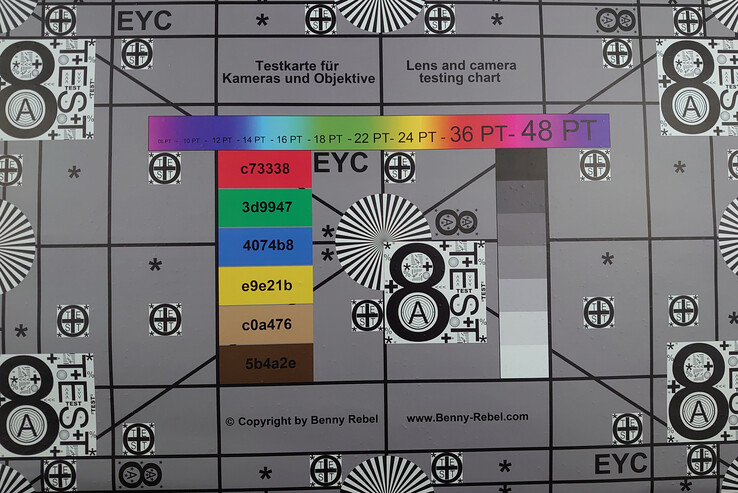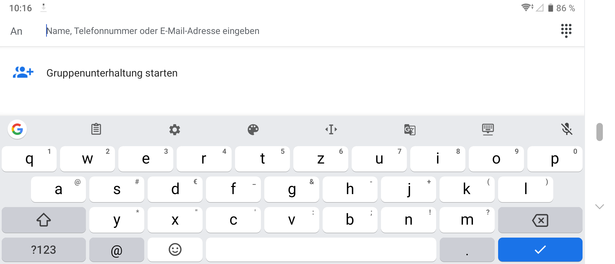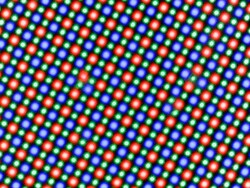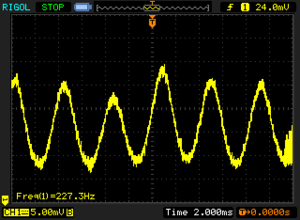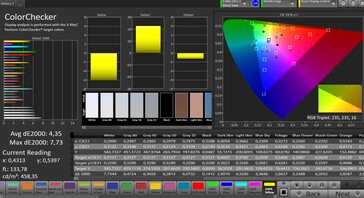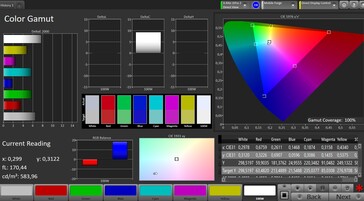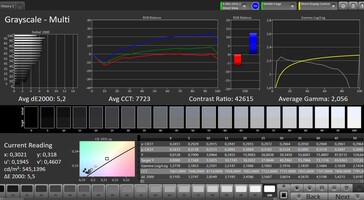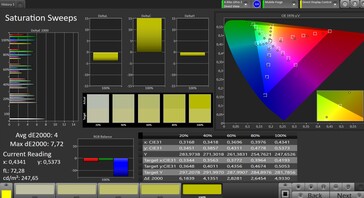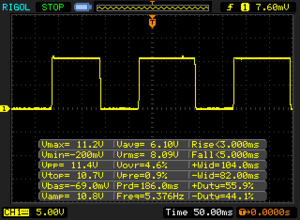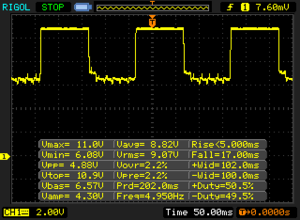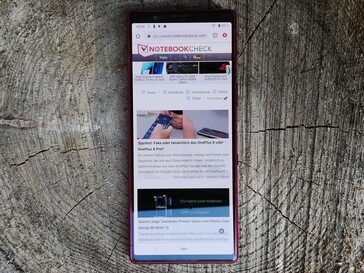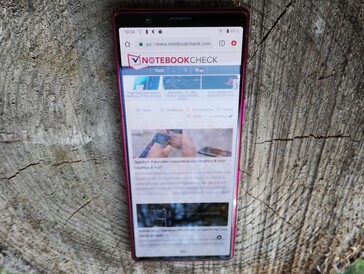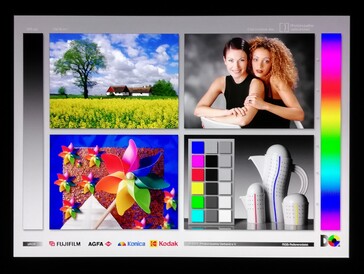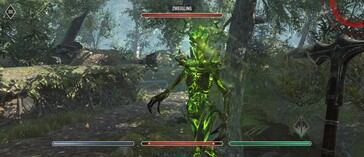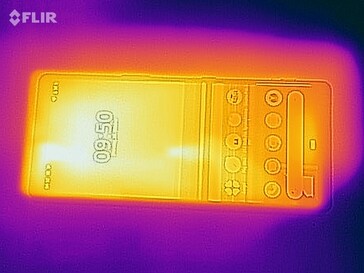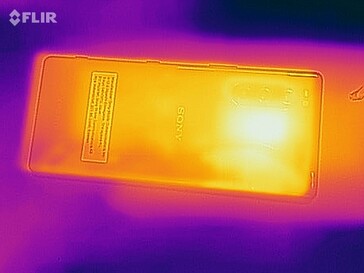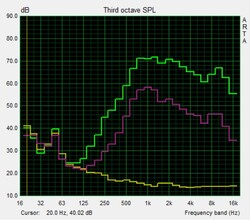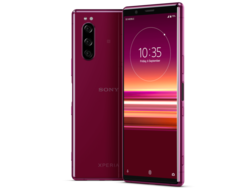Sony Xperia 5 Smartphone Review: A handy handset despite having a 6-inch display
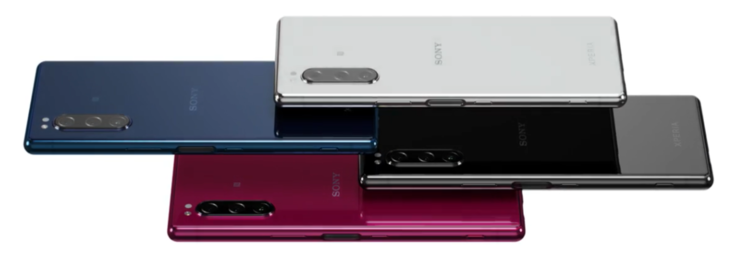
The Xperia 5 may look familiar, with it being the smaller sibling of the Xperia 1, a handset that we reviewed earlier this year. While the Xperia 5 sports a smaller display than the last Xperia that we tested, it retains its widescreen aspect ratio. The Xperia 5 is essentially a more compact Xperia 1 though, as Sony has re-used the same SoC, memory and camera sensors. So, while we should not expect any surprises, the Xperia 5 could well suffer from the same issues that affected the Xperia 1. The Snapdragon 855 and Adreno 640 will still provide a stable base for the device, though.
A 21:9 aspect ratio remains unique among modern smartphones, but many competitors offer the same or better features than the Xperia 5 does. We have included an overview below of the devices that we will be comparing the Xperia 5 against, to which you can add more if you have your eye on other handsets. You can do this with all our comparison tables too.
Devices overview
Rating | Date | Model | Weight | Drive | Size | Resolution | Price |
|---|---|---|---|---|---|---|---|
| 83.3 % v7 (old) | 11 / 2019 | Sony Xperia 5 SD 855, Adreno 640 | 164 g | 128 GB UFS 2.1 Flash | 6.10" | 2520x1080 | |
| 86.9 % v7 (old) | 11 / 2019 | OnePlus 7T Pro SD 855+, Adreno 640 | 206 g | 256 GB UFS 3.0 Flash | 6.67" | 3120x1440 | |
| 85.7 % v7 (old) | 07 / 2019 | LG G8s ThinQ SD 855, Adreno 640 | 181 g | 128 GB UFS 2.1 Flash | 6.20" | 2248x1080 | |
| 86.4 % v7 (old) | 05 / 2019 | Huawei P30 Kirin 980, Mali-G76 MP10 | 165 g | 128 GB UFS 2.1 Flash | 6.10" | 2340x1080 | |
| 87.4 % v7 (old) | 03 / 2019 | Samsung Galaxy S10 Exynos 9820, Mali-G76 MP12 | 157 g | 128 GB UFS 2.1 Flash | 6.10" | 3040x1440 |
Case - A mixture of glass and metal with good ergonomics
Sony manufactures the Xperia 5 with a metal frame, while it covers the front and back of the device with Corning Gorilla Glass 6. The Xperia 5 offers IP68 protection against dust and water too, although our review unit warns us that the USB Type-C port must be completely dry before we can use it again.
While the Xperia 5 is comparatively tall, its rounded edges make it comfortable to hold with one hand. Our review unit is also well-built and drew no cause for criticism. Likewise, the three hardware buttons all sit firmly in their housings and do not wobble or rattle.
Connectivity - DRM Widevine L1, dual-SIM and UFS flash storage
As we mentioned earlier, Sony has equipped the Xperia 5 with a Snapdragon 855 SoC that integrates an Adreno 640 GPU, 6 GB of RAM and 128 GB of UFS 2.1 flash storage. The device has a microSD card reader on board too, although its card slot can also hold a second nano-SIM. Hence, you must compromise between dual-SIM functionality and microSD card expansion; you cannot have both. The Xperia 5 supports LTE, voice over LTE (VoLTE) and voice over Wi-Fi (VoWiFi) on both SIMs simultaneously, though.
The Xperia 5 has a USB 3.1 Type-C port on board too, which supports not only charging and fast data transfer but also video output to an external monitor. Sony has certified the Xperia 5 for DRM Widevine L1, so the device can stream DRM-protected content in HD from services like Amazon Prime and Netflix.
Software - Android 9.0 Pie and additional movie software
The Xperia 5 ships with Android 9.0 Pie, while our review unit had October 1, 2019 security patches installed during our tests. The handset offers an almost stock Android experience, so it should take hardly any time getting used to it, whether you are an Android novice or a seasoned pro.
Sony preinstalls a few additional apps like Netflix and PlayStation among others, which cannot be removed. There are also apps like 3D Creator, Cinema Pro and Movie Creator for taking advantage of the Xperia 5's cameras.
Communication & GPS - An abundance of LTE bands, Bluetooth 5.0 and NFC
The Xperia 5 supports numerous GSM, 3G and LTE bands, while utilising LTE Cat. 19 for theoretically up to 1,700 Mb/s downloads. However, this only applies to using the device in single-SIM mode. Switching to dual-SIM mode forces the device into LTE Cat. 18 where it can only up to 1,200 Mb/s. The Xperia 5 utilises LTE Cat. 13 for uploads regardless of the mode in which it is operating, though. Cat. 13 corresponds with up to 150 Mb/s transfer speeds, for reference.
The Xperia 5 has an NFC chip on board too, and it supports Bluetooth 5.0 along with up to IEEE 802.11ac Wi-Fi. Our review unit averaged 255 Mb/s when downloading data and 403 Mb/s when uploading data, a far cry from the transmission speeds of some of our comparison devices. The OnePlus 7T Pro vies with the Xperia 5 for last place in our comparison tables.
| Networking | |
| iperf3 transmit AX12 | |
| Huawei P30 | |
| Samsung Galaxy S10 | |
| LG G8s ThinQ | |
| Sony Xperia 5 | |
| OnePlus 7T Pro | |
| iperf3 receive AX12 | |
| Samsung Galaxy S10 | |
| LG G8s ThinQ | |
| Huawei P30 | |
| OnePlus 7T Pro | |
| Sony Xperia 5 | |
The Xperia 5 uses GPS and GLONASS for location services, with which it can achieve a satellite fix to four metres. This only occurred when we tested our review unit outside, as it could not locate us when we brought it indoors.
The device recorded our cycle route accurately too, as demonstrated by our screenshots below. Our review unit had no issues with tracking us on straight stretches or through curved sections, so the Xperia 5 should be accurate enough for all general navigation tasks.
Telephone Functions & Call Quality - Intelligible even in busy environments
Sony preinstalls the stock Android phone app as the default on the Xperia 5. The app performs just as well as it has on other devices that we have tested and provides direct access to favourites, a numeric keypad and stored contacts.
The Xperia 5 has good call quality too. The earpiece in our review unit gets loud enough to make calls even in busy environments without voices getting drowned out by background noise. Likewise, the built-in microphone picks out our voice well too.
Cameras - 2x zoom, great colours but distortion issues
The Xperia 5 offers three 12 MP rear-facing cameras of various focal lengths and fields of view. The primary sensor has a 26 mm focal length, an f/1.6 aperture and a pixel size of 1.4 μm, making it the best candidate for general photos and night-shots. There is also a telephoto lens that offers 2x optical zoom with an f/2.4 aperture, a 52 mm field of view and a 1.0 μm pixel size. Rounding off the ensemble is an ultra-wide-angle sensor that offers a 16 mm focal length, along with an f/2.4 aperture and a pixel size of 1.0 μm like the telephoto lens does. There is an 8 MP front-facing camera too.
The latter produces detailed-looking selfies with warm colours. The sensor preserves details and fine structures well, but our test shots all suffer from a subtle fish-eye effect that distorts objects slightly. This is not the last sensor in the Xperia 5 to suffer from this issue, either. The default camera app contains a special selfie mode too that contains beautification effects including but not exclusive to larger eyes, a narrower chin and skin tone tweaks. Sony reserves a professional or manual mode for the rear-facing sensors, though.
The Xperia 5 takes decent shots with its primary rear-facing camera too. Sadly, all three rear-facing sensors suffer from the same fish-eye effect as the front-facing camera does, as our test shots below demonstrate. Even the telephoto lens does, while the issue becomes more pronounced the closer we get to a subject.
Our review unit captures plenty of details even in cloudy conditions, but the edges of objects look blurry at higher zoom levels. The telephoto lens also reproduces colours vividly, but it too has issues at high zoom levels.
The device does an acceptable job in low-light conditions too and can reproduce objects reasonably well. Colours look a bit pale though, while some areas look completely black as our test shot below demonstrates. The professional mode can help here, as it contains settings for adjusting focus, the shutter speed, white balance and the ISO. Sony has incorporated effects like a slow-motion mode and Google Lens within its default camera app too.
The primary rear-facing camera reproduces colours accurately in videos. The Xperia 5 can shoot in up to 4K at 60 FPS, although we would recommend using the preinstalled Cinema Pro app instead of the default camera app if you are shooting 21:9 videos. The former contains more settings and allows you to save recordings to various projects. You can use the Movie Creator app to combine these recordings or automatically make a highlight reel from existing videos.
We also subjected the primary rear-facing camera to additional tests under controlled lighting conditions, the results of which you can view below.
While our review unit generally reproduces colours accurately, it has particular trouble with capturing dark blue tones. Likewise, it underexposes green, yellow and brown tones, but simultaneously overexposes light shades of blue.
The Xperia 5 did not have many issues with reproducing our test chart, though. As the photo below demonstrates, the primary rear-facing camera can capture fine structures and symbols well. The top corners of the image have a slight pallor to them, but few modern smartphone cameras reproduce contrast evenly in this test, so the Xperia 5 is in good company here.
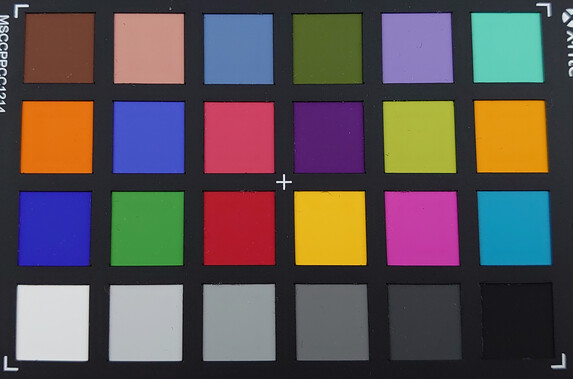
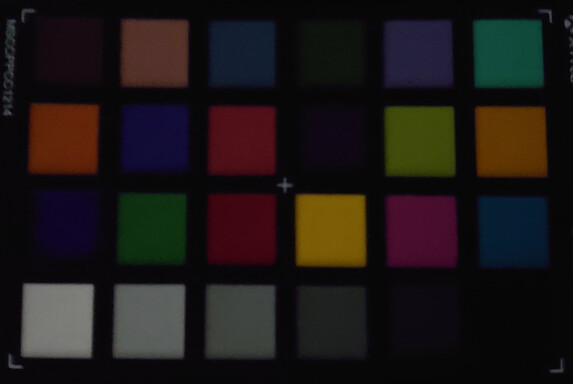
Accessories & Warranty - 24 months' warranty and headphones in the box
The Xperia 5 comes with the standard set of accessories and a 3.5 mm to USB Type-C adapter for connecting conventional headphones. Sony sells cases and other general accessories on its websites.
Sony affords the Xperia 5 24 months' warranty. Please see our Guarantees, Return Policies & Warranties FAQ for country-specific information.
Input Devices & Operation - An accurate touchscreen and fast fingerprint sensor
Sony preinstalls Google Gboard as the default keyboard, which works just as well as it does on any other device that we have tested. The device has a 10-point multitouch touchscreen that responds quickly and precisely to inputs. The Gorilla Glass protecting it also has a smooth finish to it that makes drag-and-drop movements and multi-finger gestures a cinch. We had no issues with the accelerometer or any other sensors during our tests, either.
The Xperia 5 has a fingerprint sensor for biometric authentication, although you must set a password, pattern or PIN too. Sony has placed the sensor on the frame of the device, making it easy to access with your thumb if you are right-handed. Conversely, most left-handed people will probably use their index finger to unlock the device. The sensor in our review unit authenticated our registered fingers reliably and quickly during our tests.
Display - A bright OLED panel with a 21:9 aspect ratio
The Xperia 5 has a 6.1-inch OLED panel, which as we mentioned earlier, has a 21:9 aspect ratio. The panel also operates natively at 2520x1080 and achieved an average peak brightness of 599 cd/m² according to X-Rite i1Pro 2. This value puts the Xperia 5 in the middle of our comparison table, but it ties for first with the Samsung Galaxy S10 on the evenness of its brightness distribution at 98%.
According to our measurements, the display constantly flickers at about 227 Hz. This effect is typical of OLED panels and can cause health problems for those with sensitive eyes.
| |||||||||||||||||||||||||
Brightness Distribution: 98 %
Center on Battery: 592 cd/m²
Contrast: ∞:1 (Black: 0 cd/m²)
ΔE ColorChecker Calman: 4.35 | ∀{0.5-29.43 Ø4.77}
ΔE Greyscale Calman: 5.2 | ∀{0.09-98 Ø5}
100% sRGB (Calman 2D)
Gamma: 2.056
CCT: 7723 K
| Sony Xperia 5 OLED, 2520x1080, 6.1" | OnePlus 7T Pro AMOLED, 3120x1440, 6.7" | LG G8s ThinQ P-OLED, 2248x1080, 6.2" | Huawei P30 OLED, 2340x1080, 6.1" | Samsung Galaxy S10 OLED, 3040x1440, 6.1" | |
|---|---|---|---|---|---|
| Screen | 18% | 9% | 31% | 15% | |
| Brightness middle (cd/m²) | 592 | 606 2% | 539 -9% | 561 -5% | 701 18% |
| Brightness (cd/m²) | 599 | 611 2% | 556 -7% | 560 -7% | 705 18% |
| Brightness Distribution (%) | 98 | 95 -3% | 88 -10% | 95 -3% | 98 0% |
| Black Level * (cd/m²) | |||||
| Colorchecker dE 2000 * | 4.35 | 3.46 20% | 3.78 13% | 1.5 66% | 3.7 15% |
| Colorchecker dE 2000 max. * | 7.73 | 5.64 27% | 6.95 10% | 2.5 68% | 10.3 -33% |
| Greyscale dE 2000 * | 5.2 | 2 62% | 2.2 58% | 1.8 65% | 1.4 73% |
| Gamma | 2.056 107% | 2.258 97% | 2.274 97% | 2.2 100% | 2.1 105% |
| CCT | 7723 84% | 6779 96% | 6013 108% | 6512 100% | 6553 99% |
* ... smaller is better
Screen Flickering / PWM (Pulse-Width Modulation)
| Screen flickering / PWM detected | 227.3 Hz | ||
The display backlight flickers at 227.3 Hz (worst case, e.g., utilizing PWM) . The frequency of 227.3 Hz is relatively low, so sensitive users will likely notice flickering and experience eyestrain at the stated brightness setting and below. In comparison: 53 % of all tested devices do not use PWM to dim the display. If PWM was detected, an average of 8081 (minimum: 5 - maximum: 343500) Hz was measured. | |||
The display also has a 0 cd/m² black value and an infinite contrast ratio, at least theoretically anyway. This is true of all OLED panels, though. Regardless, the display demarcates colours well, while blacks look full and deep.
However, CalMAN analysis shows that the display suffers from a blue tint. Sony includes an option to customise the display's colour temperature within the main settings menu, though. Hence, you may be able to mitigate against this blue tint somewhat.
Display Response Times
| ↔ Response Time Black to White | ||
|---|---|---|
| 8 ms ... rise ↗ and fall ↘ combined | ↗ 3 ms rise | |
| ↘ 5 ms fall | ||
| The screen shows fast response rates in our tests and should be suited for gaming. In comparison, all tested devices range from 0.1 (minimum) to 240 (maximum) ms. » 21 % of all devices are better. This means that the measured response time is better than the average of all tested devices (20.2 ms). | ||
| ↔ Response Time 50% Grey to 80% Grey | ||
| 22 ms ... rise ↗ and fall ↘ combined | ↗ 5 ms rise | |
| ↘ 17 ms fall | ||
| The screen shows good response rates in our tests, but may be too slow for competitive gamers. In comparison, all tested devices range from 0.165 (minimum) to 636 (maximum) ms. » 32 % of all devices are better. This means that the measured response time is better than the average of all tested devices (31.6 ms). | ||
Likewise, the Xperia 5 has excellent viewing angles. We noticed a slight green tint appearing at acute viewing angles, but this is often the case with OLED panels. This should not impact readability in our opinion, so you should be able to read the Xperia 5 from practically any angle.
Performance - Everyday experiences reinforce synthetic benchmark dominance
The Qualcomm Snapdragon 855 and 6 GB of RAM provide enough power to handle all everyday applications and tasks with ease. The onboard Adreno 640 GPU can also handle modern games at higher graphics settings, which we shall cover in the Games section of this review. Likewise, the 128 of GB UFS 2.1 flash storage is fast and should offer enough space for most people to install their favourite apps, along with any data or photos.
The Xperia 5 performed well in synthetic benchmarks, often finishing top of our comparison tables. Its greatest competitor proved to be the OnePlus 7T Pro, which often had the edge in memory-heavy benchmarks. Keep in mind that the OnePlus 7T Pro runs the Snapdragon 855+ rather than the regular Snapdragon 855.
| PCMark for Android | |
| Work performance score (sort by value) | |
| Sony Xperia 5 | |
| OnePlus 7T Pro | |
| LG G8s ThinQ | |
| Huawei P30 | |
| Samsung Galaxy S10 | |
| Average Qualcomm Snapdragon 855 (10330 - 14439, n=19) | |
| Work 2.0 performance score (sort by value) | |
| Sony Xperia 5 | |
| OnePlus 7T Pro | |
| LG G8s ThinQ | |
| Huawei P30 | |
| Samsung Galaxy S10 | |
| Average Qualcomm Snapdragon 855 (8342 - 11440, n=19) | |
| GFXBench 3.0 | |
| on screen Manhattan Onscreen OGL (sort by value) | |
| Sony Xperia 5 | |
| OnePlus 7T Pro | |
| LG G8s ThinQ | |
| Huawei P30 | |
| Samsung Galaxy S10 | |
| Average Qualcomm Snapdragon 855 (46 - 85, n=20) | |
| Average of class Smartphone (18 - 166, n=155, last 2 years) | |
| 1920x1080 1080p Manhattan Offscreen (sort by value) | |
| Sony Xperia 5 | |
| OnePlus 7T Pro | |
| LG G8s ThinQ | |
| Huawei P30 | |
| Samsung Galaxy S10 | |
| Average Qualcomm Snapdragon 855 (50 - 102, n=20) | |
| Average of class Smartphone (12 - 606, n=154, last 2 years) | |
| GFXBench 3.1 | |
| on screen Manhattan ES 3.1 Onscreen (sort by value) | |
| Sony Xperia 5 | |
| OnePlus 7T Pro | |
| LG G8s ThinQ | |
| Huawei P30 | |
| Samsung Galaxy S10 | |
| Average Qualcomm Snapdragon 855 (27 - 58, n=20) | |
| Average of class Smartphone (11 - 166, n=155, last 2 years) | |
| 1920x1080 Manhattan ES 3.1 Offscreen (sort by value) | |
| Sony Xperia 5 | |
| OnePlus 7T Pro | |
| LG G8s ThinQ | |
| Huawei P30 | |
| Samsung Galaxy S10 | |
| Average Qualcomm Snapdragon 855 (35 - 71, n=20) | |
| Average of class Smartphone (8.4 - 413, n=154, last 2 years) | |
| AnTuTu v7 - Total Score (sort by value) | |
| Sony Xperia 5 | |
| LG G8s ThinQ | |
| Huawei P30 | |
| Samsung Galaxy S10 | |
| Average Qualcomm Snapdragon 855 (217967 - 398720, n=16) | |
The Xperia 5 also shines in browser benchmarks, with it achieving competitive results in all the benchmarks that we ran. Our test device occupies first place in all our comparison tables save for Kraken 1.1, where our comparison devices dethrone it. The handset loads websites and media content quickly in daily use too.
| JetStream 1.1 - Total Score | |
| Sony Xperia 5 (Chrome 74) | |
| OnePlus 7T Pro (Chrome 78) | |
| Average Qualcomm Snapdragon 855 (84.4 - 120, n=17) | |
| Huawei P30 (Chrome 73) | |
| LG G8s ThinQ (Chrome 75) | |
| Samsung Galaxy S10 (Samsung Browser 9.0) | |
| WebXPRT 3 - Overall | |
| Average of class Smartphone (38 - 380, n=30, last 2 years) | |
| Sony Xperia 5 (Chrome 74) | |
| LG G8s ThinQ (Chrome 75) | |
| Average Qualcomm Snapdragon 855 (90 - 129, n=20) | |
| OnePlus 7T Pro (Chrome 78) | |
| Huawei P30 (Chrome 73) | |
| Octane V2 - Total Score | |
| Average of class Smartphone (2228 - 126661, n=194, last 2 years) | |
| Sony Xperia 5 (Chrome 74) | |
| OnePlus 7T Pro (Chrome 78) | |
| LG G8s ThinQ (Chrome 75) | |
| Average Qualcomm Snapdragon 855 (17011 - 33918, n=21) | |
| Huawei P30 (Chrome 73) | |
| Samsung Galaxy S10 (Samsung Browser 9.0) | |
| Mozilla Kraken 1.1 - Total | |
| Average Qualcomm Snapdragon 855 (1852 - 2611, n=19) | |
| OnePlus 7T Pro (Chrome 78) | |
| Sony Xperia 5 (Chrome 74) | |
| Huawei P30 (Chrome 73) | |
| LG G8s ThinQ (Chrome 75) | |
| Samsung Galaxy S10 (Samsung Browser 9.0) | |
| Average of class Smartphone (257 - 28190, n=154, last 2 years) | |
* ... smaller is better
Our review unit had around 105 GB of its 128 GB storage free upon first use, with the OS and preinstalled apps accounting for the remaining capacity. According to AndroBench, the Xperia 5 mostly matched the read and write speeds of our comparison devices that also have UFS 2.1 flash storage. Only 4 KB write speeds are a little down on what we would have expected.
The Xperia 5 does not allow for storing apps on a microSD card, and no wonder as its reader is abysmally slow. Our review unit only averaged around 26 MB/s in AndroBench with our Toshiba Exceria Pro M501 reference card, putting it way behind our comparison devices.
| Sony Xperia 5 | OnePlus 7T Pro | LG G8s ThinQ | Huawei P30 | Samsung Galaxy S10 | Average 128 GB UFS 2.1 Flash | Average of class Smartphone | |
|---|---|---|---|---|---|---|---|
| AndroBench 3-5 | 56% | 40% | 191% | 56% | 139% | 628% | |
| Sequential Read 256KB (MB/s) | 753 | 1489 98% | 791 5% | 909 21% | 832 10% | 761 ? 1% | 2235 ? 197% |
| Sequential Write 256KB (MB/s) | 211.6 | 405 91% | 182.4 -14% | 186 -12% | 193.2 -9% | 296 ? 40% | 1871 ? 784% |
| Random Read 4KB (MB/s) | 143.3 | 169 18% | 138 -4% | 138.8 -3% | 137.4 -4% | 154 ? 7% | 297 ? 107% |
| Random Write 4KB (MB/s) | 22.49 | 26 16% | 29.6 32% | 195.3 768% | 24.44 9% | 130.4 ? 480% | 343 ? 1425% |
| Sequential Read 256KB SDCard (MB/s) | 28.2 ? | 67.5 ? 139% | 82.8 ? 194% | 77.9 ? 176% | 76 ? 170% | ||
| Sequential Write 256KB SDCard (MB/s) | 25.5 ? | 46.7 ? 83% | 71.3 ? 180% | 64.8 ? 154% | 59.6 ? 134% |
Games - 21:9 makes for a great gaming experience
The Adreno 640 is a gaming powerhouse though, while we found the Xperia 5's 21:9 aspect ratio engrossing when gaming. Its smooth touchscreen prevents fingertips from feeling fatigued during prolonged gaming sessions too. Likewise, we had no issues with any sensors during our gaming tests either.
Emissions - Useful speakers but high surface temperatures
Temperature
Our measurements certify that surface temperatures on the Xperia 5 reach 29.2 °C at idle, although most areas remain at around 27 °C. The device heats up dramatically under sustained load though, with it reaching a maximum of 46.1 °C in one area. In short, the Xperia 5 feels rather hot during some tasks like gaming. However, we noticed no restrictions or thermal throttling in daily use.
(±) The maximum temperature on the upper side is 41.9 °C / 107 F, compared to the average of 35.2 °C / 95 F, ranging from 21.9 to 247 °C for the class Smartphone.
(-) The bottom heats up to a maximum of 46.1 °C / 115 F, compared to the average of 34 °C / 93 F
(+) In idle usage, the average temperature for the upper side is 27.6 °C / 82 F, compared to the device average of 32.9 °C / 91 F.
Speakers
Sony has equipped the Xperia 5 with stereo speakers that get reasonably loud and are dominated by midrange frequencies. Hence, you can often dispense with headphones and use the speakers instead, as they are good enough for occasionally watching videos or listening to music.
While the Xperia 5 lacks a headphone jack, Sony includes a 3.5 mm to USB Type-C adapter in the box, along with a set of headphones.
Sony Xperia 5 audio analysis
(±) | speaker loudness is average but good (80.2 dB)
Bass 100 - 315 Hz
(-) | nearly no bass - on average 62.7% lower than median
(+) | bass is linear (0% delta to prev. frequency)
Mids 400 - 2000 Hz
(-) | nearly no mids - on average 62.7% lower than median
(+) | mids are linear (0% delta to prev. frequency)
Highs 2 - 16 kHz
(-) | nearly no highs - on average 62.7% lower than median
(+) | highs are linear (0% delta to prev. frequency)
Overall 100 - 16.000 Hz
(-) | overall sound is not linear (121.3% difference to median)
Compared to same class
» 90% of all tested devices in this class were better, 8% similar, 2% worse
» The best had a delta of 11%, average was 35%, worst was 134%
Compared to all devices tested
» 97% of all tested devices were better, 2% similar, 1% worse
» The best had a delta of 4%, average was 24%, worst was 134%
OnePlus 7T Pro audio analysis
(±) | speaker loudness is average but good (81.4 dB)
Bass 100 - 315 Hz
(-) | nearly no bass - on average 64.7% lower than median
(+) | bass is linear (0% delta to prev. frequency)
Mids 400 - 2000 Hz
(-) | nearly no mids - on average 64.7% lower than median
(+) | mids are linear (0% delta to prev. frequency)
Highs 2 - 16 kHz
(-) | nearly no highs - on average 64.7% lower than median
(+) | highs are linear (0% delta to prev. frequency)
Overall 100 - 16.000 Hz
(-) | overall sound is not linear (120% difference to median)
Compared to same class
» 89% of all tested devices in this class were better, 9% similar, 3% worse
» The best had a delta of 11%, average was 35%, worst was 134%
Compared to all devices tested
» 97% of all tested devices were better, 3% similar, 1% worse
» The best had a delta of 4%, average was 24%, worst was 134%
Power Management - Poor runtimes and a comparatively small battery
Power Consumption
The Xperia 5 has relatively economical power consumption, with our review unit drawing between 1.3 W and 9.2 W during our tests. The device is slightly less efficient than the average of Snapdragon 855-powered handsets that we have tested but surpasses the LG G8s ThinQ and OnePlus 7T Pro.
Our review unit also comes with an 18 W charger, as we mentioned earlier in this review. Since the Xperia 5 never exceeded 10 W during our tests, the 18 W charger is more than powerful enough to keep the handset charging even under sustained load.
| Off / Standby | |
| Idle | |
| Load |
|
Key:
min: | |
| Sony Xperia 5 3140 mAh | OnePlus 7T Pro 4085 mAh | LG G8s ThinQ 3550 mAh | Huawei P30 3650 mAh | Samsung Galaxy S10 3400 mAh | Average Qualcomm Snapdragon 855 | Average of class Smartphone | |
|---|---|---|---|---|---|---|---|
| Power Consumption | -47% | -3% | 1% | 15% | 8% | -4% | |
| Idle Minimum * (Watt) | 1.3 | 2.1 -62% | 1.2 8% | 0.69 47% | 0.61 53% | 0.939 ? 28% | 0.847 ? 35% |
| Idle Average * (Watt) | 1.6 | 3 -88% | 1.6 -0% | 2.41 -51% | 1.27 21% | 1.506 ? 6% | 1.446 ? 10% |
| Idle Maximum * (Watt) | 2 | 3.5 -75% | 2 -0% | 2.51 -26% | 1.3 35% | 1.799 ? 10% | 1.63 ? 18% |
| Load Average * (Watt) | 4.4 | 5.3 -20% | 5 -14% | 3.86 12% | 6.17 -40% | 4.61 ? -5% | 6.95 ? -58% |
| Load Maximum * (Watt) | 9.2 | 8.3 10% | 10 -9% | 6.96 24% | 8.55 7% | 9.04 ? 2% | 11.3 ? -23% |
* ... smaller is better
Battery Life
Sony has equipped the Xperia 5 with a 3,140 mAh battery, a pitiful capacity for a modern flagship. Unsurprisingly, our review unit has dreadful battery life and lasted only 7:05 hours in our practical Wi-Fi test before it needed recharging. The device even falls a few minutes short of the runtime achieved by the Samsung Galaxy S10; another flagship released this year with sub-par battery life.
The Xperia 5 takes around two hours to reach full charge with its 18 W fast charger.
| Sony Xperia 5 3140 mAh | OnePlus 7T Pro 4085 mAh | LG G8s ThinQ 3550 mAh | Huawei P30 3650 mAh | Samsung Galaxy S10 3400 mAh | |
|---|---|---|---|---|---|
| Battery runtime | |||||
| WiFi v1.3 (h) | 7.1 | 15.2 114% | 11.6 63% | 11.9 68% | 7.1 0% |
Pros
Cons
Verdict - A strong smartphone, but weak cameras and underwhelming battery life
The Sony Xperia 5 is a great smartphone for the most part. Our review unit hardly put a foot wrong, offering not only good system performance but also a bright display and better ergonomics than most modern flagships. In short, the Xperia 5 backs up its good looks with equally good performance.
Sony could be one of the big players in the smartphone market, but major shortcomings keep holding it back over and over again.
But why, oh why does Sony reserve its best camera modules for OEMs? Great colour reproduction, 2x optical zoom and acceptable image quality are all good, but a slight fish-eye effect on all sensors is not. We cannot stress this enough; all three sensors suffer from the same issue. Our review unit makes a laptop chassis look curved, for example, an issue that you may have noticed from the church tower in our panoramic test shot. Were it not for this issue then we would have been able to recommend the handset even with its short battery life and inflated launch price.
Sony Xperia 5
- 09/03/2022 v7 (old)
Mike Wobker


